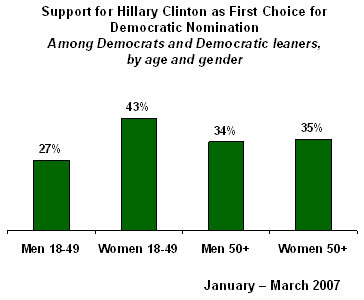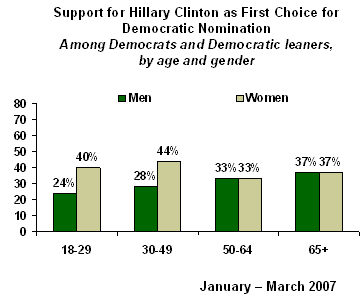GALLUP NEWS SERVICE
PRINCETON, NJ – Sen. Hillary Clinton enjoys a 10-point advantage among Democratic women when their preferences for the Democratic presidential nomination are compared with those of Democratic men. This gender gap is built almost entirely on Clinton's relative strength among 18- to 49-year-old Democratic women. There is little difference by gender in support levels for Clinton among Democrats who are 50 and older.
Basic Gender Gap
These findings are based on aggregated data from three USA Today/Gallup polls conducted from January through March of this year, yielding a total of 1,495 Democratic voters.
The overall support levels for Democratic candidates among men and women are as follows.
|
First Choice for Democratic Nomination
|
|
|
Men
|
Women
|
|
Hillary Clinton 29% |
Hillary Clinton 39% |
|
Barack Obama 21% |
Barack Obama 19% |
|
Al Gore 15% |
Al Gore 13% |
|
John Edwards 10% |
John Edwards 13% |
|
Joe Biden 4% |
John Kerry 3% |
|
Bill Richardson 4% |
Bill Richardson 2% |
|
Wesley Clark 3% |
Joe Biden 2% |
Clinton leads the Democratic field among both men and women, but Democratic women are more likely to name Clinton as their preferred choice for the Democratic nomination than are Democratic men (39% vs. 29%, respectively). It does not appear that Democratic men support any candidate other than Clinton in disproportionate numbers. In particular, Democratic men are not significantly more likely to support second-place Sen. Barack Obama than are Democratic women.
The Age Factor
The Democratic gender gap in 2008 preferences is driven almost totally by the disproportionate preference for Clinton's candidacy among 18- to 49-year-old Democratic women. There is essentially no gender gap in preferences for Clinton among Democrats aged 50 and older.

These data are quite remarkable. There is a 16-point difference in the vote preference between men and women who are in the 18- to 49-year-old age demographic. The gender gap among Democrats aged 50 and older is 1 point.
Looked at differently, Clinton's highest level of support is among 18- to 49-year-old women; her lowest, among 18- to 49-year-old men. Support for Clinton among men and women aged 50 and older comes close to the sample average for all Democrats.
The good news for Clinton is that her support among both men and women 50 and older is relatively strong. She leads second-place Obama by margins of 15 to 18 points among the older age group. This is significant given older voters' typically higher turnout levels. The bad news presumably is that Clinton has not yet been able to use her gender to special advantage among older women.
|
First Choice for Democratic Nomination
|
|||
|
Men 18 to 49
|
Women 18 to 49
|
Men 50+
|
Women 50+
|
|
Clinton 27% |
Clinton 43% |
Clinton 34% |
Clinton 35% |
|
Obama 24% |
Obama 21% |
Obama 19% |
Obama 17% |
|
Gore 16% |
Gore 16% |
Gore 14% |
Edwards 16% |
|
Edwards 8% |
Edwards 10% |
Edwards 14% |
Gore 11% |
Among Democratic voters under 50, the good news for Clinton is her great strength among women -- a 22-point advantage over Obama. This group -- 43% of whom choose her as their first choice for their party's nomination -- is clearly her most solid base of support. The bad news for the Clinton campaign comes among male Democrats aged 18 to 49, which is the only one of these four age and gender groups in which Clinton is statistically tied with Obama.
The accompanying graph displays Clinton's support among four more finely differentiated age groups. The data indicate that the 50-year mark appears to be the significant dividing point. There is little difference between those 18 to 29 and 30 to 49, and there is little difference between those 50 to 64 and those 65 and older.

Bottom Line
Clinton stands in the unique position of having a serious chance to become the first female president in United States history. To accomplish this feat, she will need to secure her party's nomination and then win the November 2008 general election.
Previous Gallup analysis has shown that Clinton's favorable rating is higher among women than among men in the general U.S. population. The analysis presented in this report indicates that Clinton also does better among Democratic women than among Democratic men -- by 10 points -- as the first choice for their party's presidential nomination.
Although she herself will turn 60 this October, Clinton's gender advantage is built almost entirely off of her significant support among younger Democratic women. Among those 50 and older, her support among women is no greater than that among men.
From a strategy perspective, this suggests that Clinton's campaign could in theory attempt to activate more enthusiasm among older women, attempting to create in them the same disproportionate appeal Clinton enjoys among younger women. At the moment, no candidate seems to stand out as having an unusual appeal to Democratic women 50 and older in lieu of Clinton.
Turnout in most primary and general elections skews old. This means Clinton's strong base of support among younger women may not be fully realized if her campaign does not take special efforts to ensure that these voters actually turn out to vote. The older skew in turnout also underscores the potential importance of an effort on the part of the Clinton campaign to increase her support among older Democratic women.
All in all, Clinton's campaign consultants presumably have already made or will need to make a strategic decision concerning the campaign's gender focus. One approach -- borrowing from the Karl Rove playbook of campaign strategy -- would be to focus on her area of strength and push to gain disproportionate turnout among younger women. Another approach would be to focus on addressing the attitudes and concerns of older women and Democratic men in an attempt to tilt their campaign preference more toward her candidacy.
Most national Democratic candidates have done better among women than among men in recent decades -- the so-called gender gap that has become a part of national politics. Women in general are disproportionately likely to vote Democratic, while men are disproportionately likely to vote Republican. The data reviewed here, however, reveal a gender gap in support for Clinton that occurs within the ranks of Democrats. This means her appeal to women is not based merely on the usual boost given to a Democratic candidate among female voters, but is more specific to her particular persona and characteristics.
It is unclear to what extent Clinton's gender will be an overt feature of her campaign -- or, for that matter, the campaigns of her opponents. But even if Clinton chooses not to focus on her gender openly, it is clear that her appeal has a significant gender skew that will most likely be a significant part of campaign dynamics as caucuses and primaries get underway early next year.
Survey Methods
Results are based on telephone interviews with 1,495 Democrats or Democratic-leaning independents, aged 18 and older, conducted between January and March 2007. For results based on the total sample of national adults, one can say with 95% confidence that the maximum margin of sampling error is ±2 percentage points. The margin of sampling error for each individual subgroup presented in the tables above varies, depending on the sample size involved, but is always higher than the sampling error for the total sample. In addition to sampling error, question wording and practical difficulties in conducting surveys can introduce error or bias into the findings of public opinion polls.